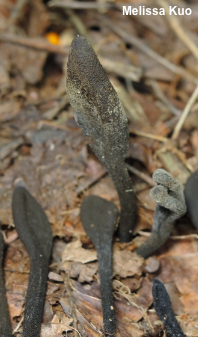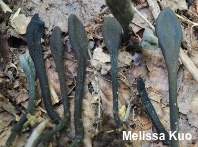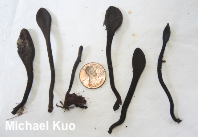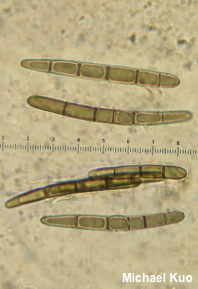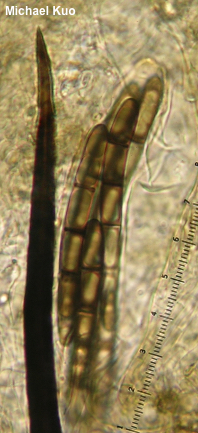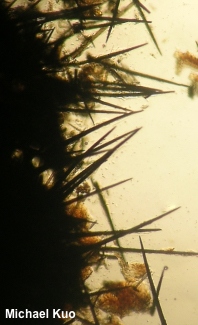| Major Groups > Clubs & Corals > Trichoglossum farlowii |

|
Trichoglossum farlowii [ Ascomycota > Geoglossales > Geoglossaceae > Geoglossum ... ] by Michael Kuo They're called Trichoglossums because they trich you. You think they're Geoglossums (for example Geoglossum umbratile) but then discover, under the microscope, that they are covered with setae—long, lance-shaped structures that are dark brown in KOH. "Holy heck!" you declare. Trichy little things. If you were a specialist in the Geoglossaceae (there actually are such people; I even know one, and he's otherwise normal) you might have known you were looking at a Trichoglossum from the onset, before the microscope, due to the very finely velvety surfaces (a result of the setae) and the slightly larger, more head-like, diamond- or spade-shaped head. However, species of Geoglossum can have wide heads and scurfy surfaces, so even you, Glossum Sensation, might need to consult microscopic features. Among species of Trichoglossum, Trichoglossum farlowii is distinguished by its spores, which have 1–5 septa. Other species have more septa, and are separated by spore morphology (dimensions, number of septa) and the number of spores packed into each ascus; see Mains (1954) for a key. Preliminary DNA research (Hustad et al. 2013, Ekanayaka et al. 2017) indicates that some of the traditionally defined species may need to be split up to represent phylogenetic differences between continents—and that the genus Trichoglossum contains at least one group of species (including Trichoglossum farlowii and Trichoglossum walteri) that may require its own genus. The collection illustrated and described here actually represents two mushroom species: Trichoglossum farlowii and a very tiny fungus, Gelatinopsis geoglossi, that is parasitizing the Trichoglossum; see the linked page for the second fungus. Description: Ecology: Saprobic; growing gregariously, often in moss, on the ground in hardwood and conifer forests; sometimes growing on moss-covered logs; summer and fall; originally described from Massachusetts; found in eastern North America from the Maritime provinces to the upper Midwest, the Appalachians, and Florida. The described and illustrated collection is from North Carolina. Fruiting Body: Club-shaped, with a well defined head that is clearly separate from the stem; 4–9 cm high. Head: 11–40 mm high; 3–11 mm wide; becoming flattened; spear-shaped to spatula- or diamond-shaped; sometimes developing a broad longitudinal groove; black; very finely velvety or nearly bald, at least to the naked eye; dry. Stem: 3–5 mm wide; finely velvety to finely hairy (visible with a hand lens); black; dry; basal mycelium black. Flesh: Thin; whitish; not changing when sliced. Odor: Not distinctive. Microscopic Features: Spores 55–75 x 4–6 µm; subfusiform, subclavate, or subcylindric; smooth; with 1–5 septa; brown in KOH, with darker septa. Asci 8-spored; 120–140 x 10–15 µm; fusiform. Paraphyses 2–5 µm wide; filiform; exceeding the asci by 10–15 µm; septate; smooth or slightly encrusted; apices rounded, subclavate, or irregularly enlarged; brownish-walled in KOH. Setae scattered throughout hymenium; 120–180 x 7.5–15 µm; fusiform; smooth; dark brown. Setae on stem surface densely packed, similar to hymenial setae but generally longer (up to 250+ µm). REFERENCES: (M. C. Cooke, 1883) E. J. Durand, 1908. (Nannfeldt, 1942; Seaver, 1951; Mains, 1954; Smith, Smith & Weber, 1981; Phillips, 1991/2005; Hustad et al., 2013; Baroni, 2017; Ekanayaka et al., 2017; Quijada & Pfister, 2021; Dasgupta et al., 2022.) Herb. Kuo 08101912. This website contains no information about the edibility or toxicity of mushrooms. |
© MushroomExpert.Com |
|
Cite this page as: Kuo, M. (2022, June). Trichoglossum farlowii. Retrieved from the MushroomExpert.Com Web site: http://www.mushroomexpert.com/trichoglossum_farlowii.html |
